The large, black, beaked creature that carefully made its way among the risers of the Arcata Playhouse was kind of scary. But young Alexandra was not afraid. She turned in her front row seat and peered at him as he approached. She had a secret. She had met the man who now wore stilts and a mask before the Circus Remedy show began. He'd asked her to become part of his performance. She had a part to play — nothing too complicated — and she knew, now was the time.
The performer, juggler and stilt walker Patrick McGuire, had told her he would pick her out from the crowd and escort her to the stage, which he did, navigating on four stilts that made him tower above her. There she found Chrisse Harnos — formerly a Hollywood actor, now an Arcata nonprofit director — who served as the show's emcee.
As Alexandra picked up a bright red ball that was sitting on a silver pedestal on stage, Harnos took the pedestal off-stage and left the little girl to wait clutching the ball until the juggler emerged from backstage dressed in a three-piece suit and a gray bowler, and, as per instructions, she handed him the ball.
He proceeded to juggle the ball along with several others like it. Before the show was over, he'd also juggled his bowler hat, an umbrella, a briefcase and the usual collection of balls and clubs.
McGuire, a circus pro who honed his skills working for years with Cirque du Soleil, was in Arcata on behalf of the organization that Harnos runs with her partner, Anthony Lucero, also a former Hollywood actor. It's called Circus Remedy. Don't be surprised if you haven't heard of it. McGuire's show at the Playhouse and another like it the day before at Sunny Brae Middle School were the first two events the group has done locally, and neither one was open to the general public.
Hardly anyone else has heard of Circus Remedy either, apart from a small circle of performers the group supports and the children they have entertained, here and there. But for Harnos and Lucero, the nonprofit has become a personal mission, a healing force, an potent source of meaning in a cold and crippled world.
In spring of 2007, Lucero and Harnos moved Circus Remedy headquarters to a house in Arcata. To some degree, running the nonprofit is a juggling act itself with just a small part of their time spent doing the good works they set out to do, the rest spent talking on the phone or sending out e-mail to raise money or make arrangements, that and dealing with paperwork. It's work that can be done from anywhere. Arcata, with its small town atmosphere and easy access to the wonders of nature, was as good a place as any.
You might think they came because they'd heard about that training ground for clowns, the Dell'Arte International School of Physical Theatre, or knew about the Humboldt Circus group from the Humboldt State campus, or the annual juggling festival held in Arcata. They hadn't heard of any of that.
Aside from being a nice place to live, the prime attraction seemed to be the fact that it was not Hollywood, a place they'd escaped. Harnos and Lucero both started working in Hollywood when they were just leaving their teens. Each landed a small part in a high-profile teen movie early on: Lucero was in the Christian Slater vehicle Pump Up the Volume, and went on to roles in a collection of movies and TV shows. Harnos had a part in Richard Linklater's Dazed and Confused.She later spent the better part of a decade as a recurring cast member on the TV hospital drama ER, playing Jennifer Greene, estranged wife of Dr. Mark Greene (portrayed by Anthony Edwards).
Lucero and Harnos met randomly at a reading for some film in which neither got a part, eventually moved in together and have been close friends since.
Central to their transition out of acting (and Hollywood) is a script written by Lucero for an as yet unmade indie film with the working titleThe Clown. The plot revolves around a love triangle involving a European circus clown, his trapeze artist wife and a woman the clown meets when the circus comes to town. The clown and his wife have a child — a little girl — who adds further complication to the story.
As the film project started to jell, Lucero cast Tim Roth and Samantha Morton in starring roles and lined up the Dave Matthews Band to do soundtrack music. Lucero's plan was to direct the film himself and shoot it with a real circus performing in front of real audiences.
"A producer I knew got me $70,000 off the bat," said Lucero in a conversation in the living room of the home he and Harnos are renting in Arcata. Settling into an easy chair he recalled how he used the seed money to travel through Europe with former Olympic gymnast Terry Notary, who'd developed some circus chops working with Cirque du Soleil before shifting gears and establishing himself as a top Hollywood stuntman and choreographer.
"When I cast Tim Roth, he had just done Planet of the Apes," said Lucero. "Terry was his stunt double and choreographer for the ape movement." Notary introduced Lucero to various circus folk he knew from his Cirque days. Potential cast members for the film's circus troupe were enlisted. They even found the ideal big top tent.
"We got to the point where everything was lined up," said Lucero. "All we needed was the money to make it happen, around $7 million."
Then, quite unexpectedly, things took a strange turn.
"I was poisoned," said Lucero.
As Lucero tells it, he had gone to the Los Angeles home of a friend he had known since college who poisoned him by adding a massive amount of chlorine to a hot tub before he bathed in it.
"He didn't deny it," said Lucero, explaining that the friend offered vague excuses for what had happened. While he decided against reporting the incident to the police, he is certain that the incident contributed to serious medical problems that followed.
"I'd say the poisoning was the straw that broke the camel's back," he said. "I was living a sort of unforgiving life: I was drinking a lot and not eating particularly well, not getting any rest, flying here and there. Being poisoned, my body just couldn't take it. I'm hesitant to say that that was the sole thing."
Whatever the cause, his liver stopped doing what it's supposed to do. "I couldn't eat. I really thought I was going to die," he said.
"He had turned orange; he was losing weight," said Harnos, who tended to him at the time and still keeps a keen eye on his dietary habits.
As Lucero became increasingly ill, he ended up spending a lot of time in clinics and hospitals where he encountered others facing life-threatening diseases.
Lucero was not a stranger to hospitals. He'd gone through some medical problems earlier in life and both Lucero and Harnos spent time as volunteers in a Los Angeles facility that served babies with AIDS. Lucero noted that he also spent time in a cancer ward in connection with a film he was in in 1991, Molder of Dreams. "It was a true story about this boy, Kent Soderman, who died of cancer," he said. "I played Kent. It told about how he inspired this teacher [Guy Doud], who became Teacher of the Year."
Pausing to reflect, he gazed out the window before continuing. "The one thing everyone has in common in these places, whether they're old or young — they're out of society. It's like being in exile.
"The other thing you find is that the people are incredibly vulnerable emotionally. There's no bullshit. They speak to you directly, honestly. In a way it can be a beautiful thing. You don't ever feel more alive than you do when you're teetering on the verge of death."
Needless to say, his health problems put The Clown on hold. "The movie stopped when I stopped," said Lucero. "I basically went away to try to survive."
A friend offered the use of a house in Montana, far from Hollywood, and the two actors settled into a calmer lifestyle for a time, one focused on healing. That's when the concept for Circus Remedy took root. Lucero credits Notary with coming up with the initial seed.
"I was telling Terry it seemed a shame that we were going to create this circus — we were buying a tent, and we had all these performers — but when the movie was over we'd just say goodbye like you do with actors and movie crews," said Lucero.
Harnos, coming in from the kitchen with mugs of hot tea, completed the story: "Terry said, ‘Wouldn't it be great if we could visit children's hospitals?' It took two years of jumping through hoops to get 501(3)(c) status and raise some money, but that's what we did."
The project served an immediate purpose: It gave them something positive to think about, pushing aside negativity.
"The idea was to change focus," said Lucero. "I needed to refocus on what I thought was a magical thing — and it certainly wasn't Hollywood or films — it was the circus. I had written that script about the circus in large part in reaction to a business and a culture I despise.
"The circus is one of the most beautiful things I've known in my life. It creates this encapsulated world that's inspiring, that says to all who witness it, ‘Anything is possible. The world is magical. The world is funny. The world is beautiful.'"
While he did not bring it up initially, another aspect of the circus experience is seeing people put themselves into death-defying situations, flying through the air on a trapeze for example.
"It's about dealing with fear in a positive way," said Lucero. "That's part of what we're trying to do here. I know a lot of people are stuck in fear. That can be one of the biggest things in conquering illness and regaining your life: readjusting your focus. What I've found is, your body will follow wherever you take it. If I focus on something dark, I'll go to that place. And when I'm focused on something light, no matter what shape I'm in, I'll go to that place."
"We've talked a lot about showing kids that the world is a magical place," added Harnos. "When kids see the magic, when they're watching something that seems impossible, all things become possible."
While the formative idea was to bring the circus to kids in hospitals, when they filed papers to make Circus Remedy an official nonprofit charity, Harnos and Lucero wrote a much broader mission statement.
"Our goal is, ‘interrupting the suffering of children with the laughter, wonder and magic of the circus,'" said Harnos, reciting it from memory. "And we've been open to anything."
The result of that openness, and a loose interpretation of their mission, is a series of projects that are literally and figuratively all over the map, with some that seem to be driven purely by random chance.
By the summer of 2006, the couple had relocated to New York and was staying with Harnos' family. While working on plans to do what they'd originally set out to do — put on a clown show in a children's hospital — Tomás Kubínek, a Czech clown they'd met through Notary, introduced them to Sarina Condello, a Canadian yoga/movement teacher also known as "The Barefoot Dancer."
While Condello is not a circus person per se, one need look no further than the opening page of her website to see how Lucero and Harnos would see her as a kindred spirit. There you'll find this quote from New Age guru Deepak Chopra: "Giving connects two people: the giver and the receiver. This connection gives birth to a sense of belonging."
Condello was planning a teaching trip to Africa. Could Circus Remedy help with funding? It was certainly beyond the original mission, but, as Harnos put it, "We figured, why not?" The dancer was deemed a circus "ambassador" and ended up teaming with the African circus/drum and dance group Kihumbe to visit AIDS orphanages and a youth prison in Mbeya and Iwambi, Tanzania. With assistance from a couple of nutritional supplement companies, Condello also brought vitamin and mineral supplements and 100 pounds of dried goat's milk to share with the children.
Meanwhile Harnos and Lucero completed arrangements for Kubínek and another clown to perform for a couple of hundred children from local hospitals, the Make a Wish Foundation, Big Brothers Big Sisters and other groups from East Hampton, and for a visit to the Children's Aid Society in Manhattan by Ukrainian clown Bogdan Khartchenko from the Cirque du Soleil.
The organization and its mission continued expanding in 2007. Along with more hospital children's ward visits and a session at Paul Newman's Hole in the Wall Gang Camp (a retreat for children dealing with cancer), they brought clowns to Camphill Village, a home for children and adults with developmental disabilities and to the Clifford Beers Clinic for families affected by sexual abuse.
Again through a connection with Kubínek, they met Jessica Hentoff, who was organizing a trip to Israel by the St. Louis Arches Youth Circus. With partial funding from Circus Remedy, the youngsters from Missouri joined forces with Arab and Israeli kids from the Galilee Youth Circus to perform in hospitals and clinics in Jerusalem, Galilee and Tel Aviv.
Just before Christmas they sent a Canadian clown and her dog off on a month-long trip visiting hospitals and orphanages in India. Plans for the future include bringing performers to Eastern Europe to connect with abandoned children who live in sewer tunnels in Bucharest, and an even more ambitious plan to visit refugee camps in Darfur.
"It may sound incredibly corny, but when we go into these dark places, I often feel like the kids are shining a light on us," said Lucero. "I don't think we've made a single visit where the kids didn't give more than we did."
Once Circus Remedy had relocated to Humboldt County and settled in, Harnos and Lucero began thinking about doing something locally.
Inspiration came from a project they did in southern California earlier this year. Harnos had heard from an old friend who has a child attending an elementary school in Malibu. A first grader at the school is fighting cancer and has been bedridden while undergoing chemotherapy. All of the kids in his class were feeling an emotional impact. Could Circus Remedy do something?
Harnos is quick to admit that helping kids in affluent Malibu is not exactly part of the group's mission, but ultimately she figured, why not?
In October Circus Remedy arranged for Cirque du Soleil juggler Patrick McGuire (yes, the same guy who later came to Arcata) to perform at Webster Elementary School in Malibu, and on a one-on-one basis in the home of the sick child. The kids at the school then made get-well-soon artwork based around tracings of their hands — "messages of love and hope" as Harnos describes them — to be sent to sick kids at Childrens Hospital Los Angeles and to a pediatric hospice. Thus the Circus Remedy "Little Hands Project" was born.
"Our plan is to take what they made and create little movies from it," explained Harnos. "It's about joining forces, connecting healthy kids with kids who are struggling with illness. It's a community effort to make that happen."
The "little hands" artwork will be incorporated with short films Lucero has been making and taped portions of Circus Remedy performances to make what Harnos describes as e-books, essentially DVDs. Those are to be distributed to children's wards in various hospitals.
A Humboldt version of Little Hands is now in the formative stage. McGuire's visit just before Christmas was part of it. The juggler's performance on a Thursday afternoon at Sunny Brae Middle School capped a whirlwind of activity for the students on the last school day before their year-end vacation. The whole school had gone to see the movie The Golden Compass earlier.
But the day was not over for a couple of dozen kids enrolled in Roadrunners After-Hours, Sunny Brae's after-school program (named for the school mascot).
After the final bell marked an end to the school day, a somewhat unruly bunch filed into a designated classroom furnished with a foosball game, a couch and a few beanbag chairs along with the usual school tables and chairs.
Callina Wood, a Vista volunteer who helps supervise the after-school program, explained that about 40 kids are enrolled in the Roadrunners program. The Little Hands Project will be the first activity for something called the Caesar E. Chavez Service Club, a state-funded volunteer initiative led by Maria Shriver, wife of Gov. Arnold Schwarzenegger.
"The Circus Remedy thing is our big project to kick things off," said Wood. Of course, reproducing what had been done with first-graders in Malibu won't fly with sixth-, seventh- and eighth-graders in Sunny Brae. "We're trying to make it more middle-school oriented," said Wood. "Instead of doing handprints or whatever, we want to film them doing a magic show or something like that."
So, on this last school day before the winter holidays, the kids had something different after school — a visit from the Circus Remedy folks and the juggler they'd just seen perform.
McGuire stood in front of them and fielded questions about how he ended up with a career in juggling — basically practice, practice, practice — and about how he manages to juggle irregular objects like an umbrella, a hat and a ball. He offered a basic lesson in juggling patterns and their variations. "Through practice you can create an endless number of patterns," he explained. "You just have to learn the pattern and know which thing is where."
When Harnos and Lucero took center stage in the classroom they explained just a bit about the work they've been doing before brainstorming about what the kids might do with the nascent Little Hands Project.
"We want your ideas," Lucero told them. "We want you to know if you have a wacky idea like we had, you can do something with it. We started this whole thing with $2,000 while we were living in Montana, and now we have performers going all over the world. It doesn't take money — it just take belief."
Someone brought up the magic show idea Wood had mentioned. Others suggested making a newspaper or a blog that would report on the project's progress. One excited young lady suggested going door-to-door fundraising and shooting digital photos of all donors to create a collage of faces, an idea that Lucero embraced enthusiastically.
In the end nothing was decided except that the question of what to do will be revisited when school resumes after the New Year. After a wild session with McGuire giving hands-on instruction to any takers and juggling anything handed to him, the Circus Remedy crew headed for home to make plans for the Friday night show at the Arcata Playhouse.
Since there's no children's hospital or the equivalent locally, they'd decided to invite families involved with Humboldt Community Breast Health Project, Humboldt Hospice, CASA and the Emma Center, serving victims of domestic violence.
"We thought, why not reach out to every organization we can think of?" said Lucero, admitting he was unsure who might show up since the whole thing had been pulled together on short notice.
As it turned out the crowd Friday was fairly sparse, with grownups outnumbering kids. Alexandra, the little girl with the red ball, was not a needy kid; she'd come with her dad, a drummer in Gregg Moore's Bandemonium, a raucous brass band that opened the show with a set of circus-esque music from all around the world.
McGuire was in fine form. The audience laughed, gasped and applauded at his amazing feats. All in attendance seemed to be forgetting the troubles of the day.
"It wasn't a huge show, but a couple of families from each of the organizations was there," said a satisfied Lucero. "And if just one person was touched, that's enough for me."
As a girl and her mother paused at the door before heading out into the night, they thanked him, and he thanked them for coming. And you could tell there was some sort of healing going on, one way or the other.
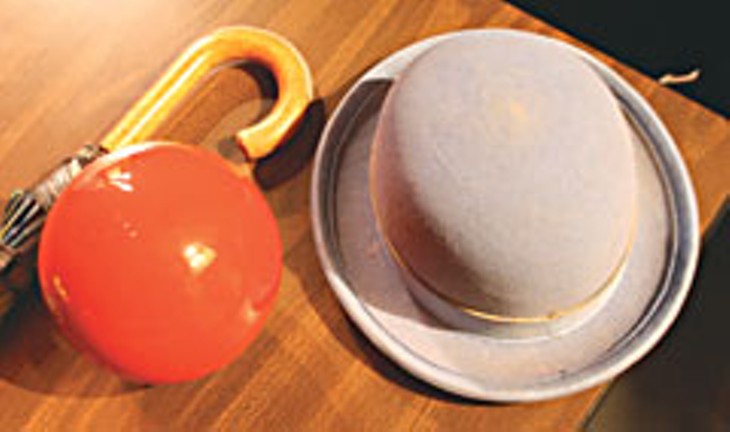
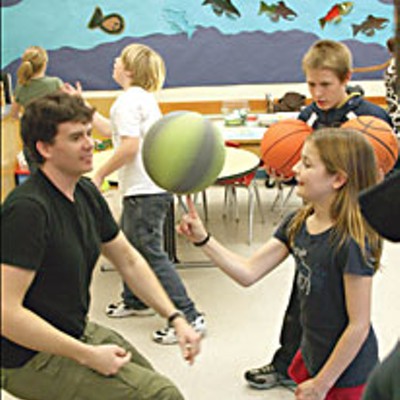
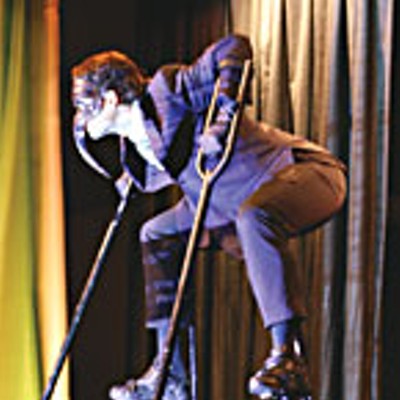
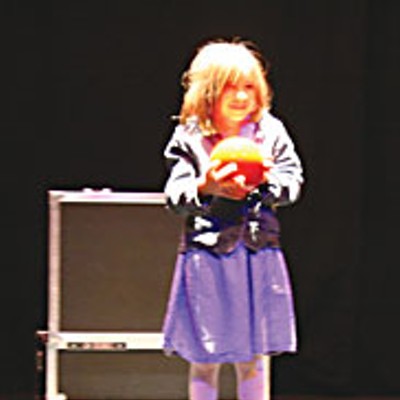
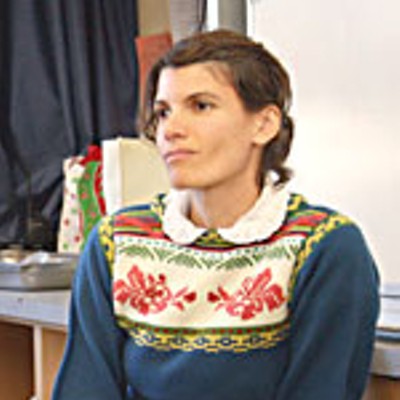

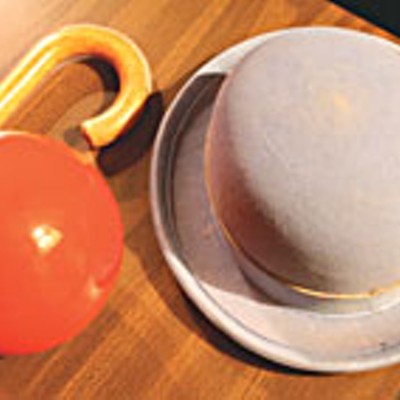
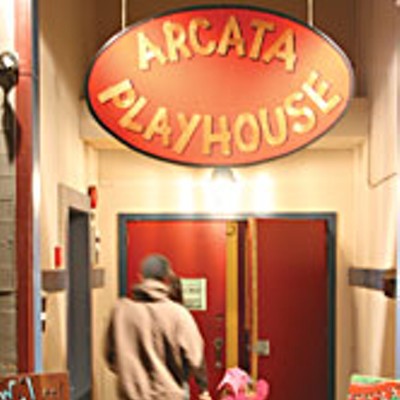


Comments